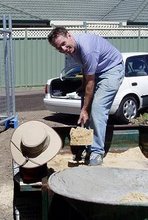
A while ago I had the good fortune to see an exhibition of Chinese dinosaur fossils, and now that I have a blog I'll repeat some comments I recorded at the time.
The exhibition was fairly small, and the information available was limited, but appropriately geared towards the general public. There were a number of reconstructions of skeletons, and some models of what the dinosaurs might have looked like in real life, and some of the fossils themselves (copies, I suspect).
The best feature of the exhibition was a PhD student from the University of Queensland, who was there in an official capacity to talk to anyone who was interested, and was able to go into much more depth than was available in the small bits of text on the exhibits. He gave me and a few others a very clear discussion of the major classification of dinosaurs into "lizard hipped" and "bird hipped" forms. He also did a great job of conveying to some other visitors the complexities of relationships between various forms, and how evolutionary change and in particular the rise of birds does not simply involve progressive change in one lineage, but a range of forms with the development and loss of various characteristics in different lineages. For example, birds are descended from the lizard hipped dinosaurs; not the bird hipped.
His own work is on biomechanics, and in particular on birds and dinosaurs.
One striking thing about dinosaurs is the way they can capture the enthusiasm of young people. There was a little boy there, about five years old, who nevertheless knew the names of many dinosaurs, and pronounced them better than I can manage. His mother said that he gets irritated with plastic toy dinosaurs that have anatomical errors. He was talking with the PhD student about the velociraptor model, because the model was given with feathers; a plausible hypothesis not confirmed by direct fossil evidence, but based on the close relationship of the velociraptors to other dinosaurs which have been found with feathers.
The dinosaur finds from China over the last decade have been a revelation on the close association to birds, and the spectacular preservation has revealed fine details of the life of an ancient world.
I'll have more to say about this in another post! In the meantime, what you see at the head of this post is an artist's impression of Sinornithosaurus milleni based on these fossils. Artist is James Reece; image available in the feathered dinosaurs photo gallery of the link above.
Saturday, 28 April 2007
Chinese Dinosaurs
Posted at
4/28/2007 03:44:00 am
![]()
Labels: evolution
You can subscribe to the comments for just this post.
Consider subscribing to:
 Post Comments (Atom)
Post Comments (Atom)



I went too, although it was a couple of years ago. Interesting exhibition, was pleasantly surprised to see people as interested in the feathered critters as this dinosaur fanatic.
ReplyDeleteI just want to say that your work is great, please keep it coming! And it doesn't hurt to have another Australian in the blogosphere.